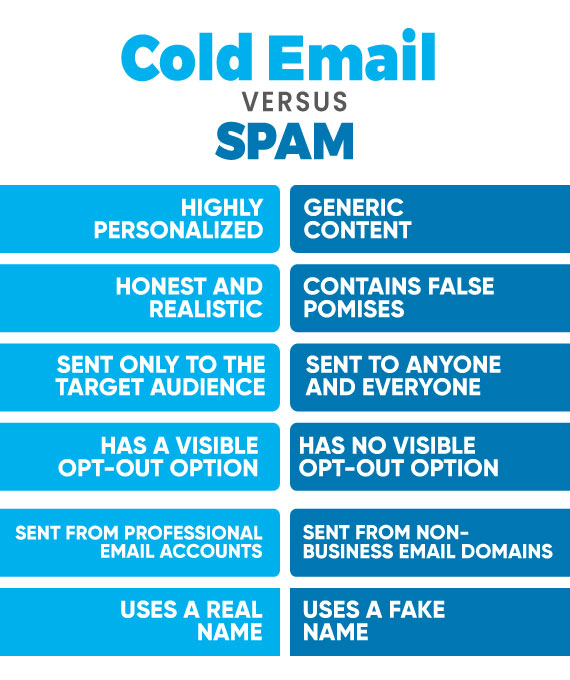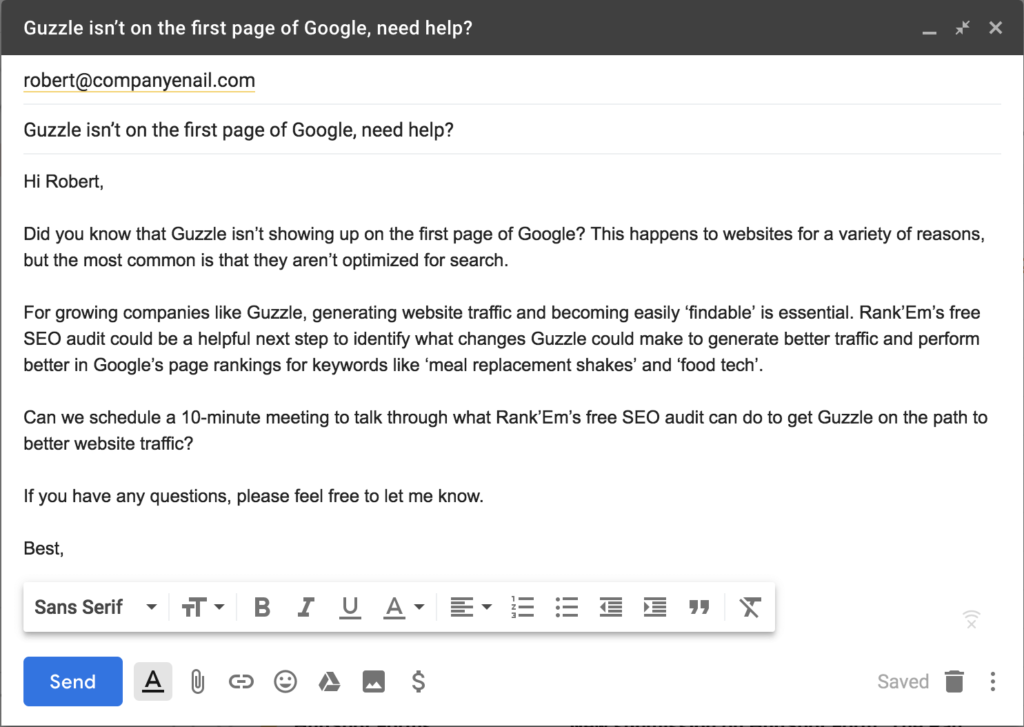When you take your first steps into email marketing, you start pondering the differences between direct-response emails and spam.
Knowing the differences between these two categories of emails can help improve your business strategy, although many email marketers aren’t concerned about it.
In fact, successful email marketing businesses, including ours, have built the most robust email marketing strategies that ideally have zero spam email characteristics.
No one wants to end up in their customer’s spam email boxes. This is why we are here to help you tell the critical differences between cold emails and spam, enlighten you about their purpose and teach you how to avoid spam folders, and nail your cold emails.
To Make A Long Story Short, Is Cold Email Spam?
No, cold emails are not spam. Instead, these are one of the highest ROI-generating activities for a growing business.
Cold Emails: Legal or Not
It’s always better to go further with a confident state of mind, yet a lot of us wonder if cold emailing is considered legal.
Yes, cold emails are legal.
Although different regions have variations in laws and regulations about the legality of cold emails, in most places across the world, sending out cold emails is legal if the marketer can make appropriate email content that fits into the category and doesn’t involve any spam attribute.
However, always remember that you need to get your audience to opt-in for email subscriptions.
Explaining Cold Email VS Spam Email


Cold Emails
We can define cold emails with examples of cold calling. Whether you implement cold calling in your business or not, you will get calls from various companies that intend to sell products. So we are assuming you know the basic concept.
Cold emails are a written version of Cold Calling.
Simply put, you send a cold email to a potential customer who has not interacted with you. Using this cold emailing concept, a business can send customized & personalized emails to make sales, engage in brand marketing, and increase their audience to a bunch of new prospects.
Cold emailing is way less annoying than cold calling from the context of the receiver.
It’s an outbound sales tactic gaining immense popularity, and the effectiveness of this email marketing strategy is increasing daily. So, people now know that cold email works.
According to recent studies, the average ROI from email marketing can scale up to 4400%. This means marketers get 44 Dollars in return per Dollar invested. And most email marketing revenues are generated by cold mailing.
Although people are never bothered by any sales-provoking texts or calls, the average response rate for cold emails is 2% to 10%, which is a good percentage according to cost. And email marketing, with better approaches, gets rates above 40%.
The general approach of cold calling is that your business will collect leads that fit your product criteria. A salesperson will send them cold emails mentioning product names, benefits, offerings, and reasons one should buy that specific product.
In addition, they cross-check the recipient’s email address before sending it and make sure that the mail lands in the right mailbox.
Here’s what a good cold email looks like.


Characteristics of Cold Email
- Emails with a real sender name and email address.
- A cold email includes a subject line relevant to the company’s intent.
- Cold emails are written in a friendly and conversational tone rather than one resembling ads.
- The sender includes a full signature, business address, and proper contact information.
- You will see a valid opt-out option, usually in the P.S.
Spam Email
Email that promotes irrelevant offerings without regard to the needs or interests of the receiver. Spammers make generic mass emails and send them to countless unqualified audiences.
Here their hope is, willingly or unwillingly, someone will respond. So the marketers, after sending spam emails, sit back and wait with their fingers crossed.
Here’s what a Spam Email looks like.


Characteristics of Spam Emails
- Fake sender’s name.
- A misleading subject line.
- The email content does not identify the message as an advertisement.
- These emails don’t have any signature from the sender or their business address, like genuine business communication.
- Spam emails will not provide a legitimate opt-out option to the receiver.
The conceptual difference between these two emails is that cold emails provide value to potential clients while spam emails don’t.
15 Cold Email Techniques for Avoiding Spam Folders

- Don’t use spam words. You can google spam words and make sure your cold email doesn’t contain any of them.
- Avoid using caps as much as possible, and make the subject line short.
- Refrain yourself from attaching any unexpected files.
- Don’t send too many emails at once.
- Include an opt-in form.
- Allow receivers to opt-out.
- Ensure your sender’s information, including email address, domain name, and routing information, clearly says who you are.
- Include your company’s physical address.
- Make sure the recipient’s email address is correct.
- Keep an excellent word-to-word ratio in your cold emails. Not too many images or too many texts.
- Always check your spelling and grammar since Gmail holds grudges against marketers who don’t proofread their emails. Make everything correct and precise.
- Make an outstanding format for your cold emails. And also, properly monitor your engagement metrics.
- Let an email spam checker analyze your emails by running them through spam filters. These spam checkers will detect issues that can cause your emails to move into the spam folder or hinder deliverability.
- There are three authentication processes: DKIM (DomainKeys Identified Mail), SPF (Domain Name Service), and DMARC(Domain-based Message Authentication); set up all three of these and make your emails less likely to end up in spam folders.
- Using trustworthy outreach tools helps your cold emails avoid the spam folder.
10 Proven Ways To Nail Your Cold Emails

Here, we’ve compiled the best suggestions to make attractive cold emails. Utilizing them will ultimately bring in more responses.
Have a look.
Real-Time Sales Data & Insights
Utilize real-time sales data and insights to plan your cold emails. These will help you know where to focus your time and energy to achieve the most effective results.
Identify & Pursue a Goal
For emails, identify what your goal is. Each piece of cold email content you make has to be based on a single goal. Common goals include but aren’t limited to promoting new products or services, gaining traffic, branding, or boosting your business’s social media presence. Push a single goal from top to bottom of your content.
Send to the Decision Maker
Your recipient should be the decision maker of a business that oversees your business purpose.
Client Research
Research your client and make a fantastic, eye-popping email. Find out their interests, and competitors and add value.
First Hour is the Best Hour
Office employees check their emails in the first hour of the day. As a result, sending cold emails during the first working hour will increase the likelihood of it being read.
Email Checklist
To stand out, make a cold email checklist that includes what characteristics your email must have, and make sure it’s organized adequately before clicking the send button.
Worthy Subject Line
Make the subject line simple, but make it worthwhile for the receiver. For example, “Strategy to get more effective leads,” “Boost your business platforms,” etc.
Solve Problems
Show your recipients that the email is for them. Send personalized emails focused on challenges and bring solutions for them.
Structure
Grab your prospect’s attention with the first sentence. In the following one or two sentences, make an impression on them by mentioning a problem they are facing. Give them proof of how your business helps, and lastly, go for an action-driven approach.
Here’s an example-


Wrapping Up
We hope this blog helps you take a step towards business growth. Cold emails are important tools for marketers that can bring good profit and a significant number of loyal customers. Use your cold emailing strategy correctly and enjoy all the benefits it brings for your business.

